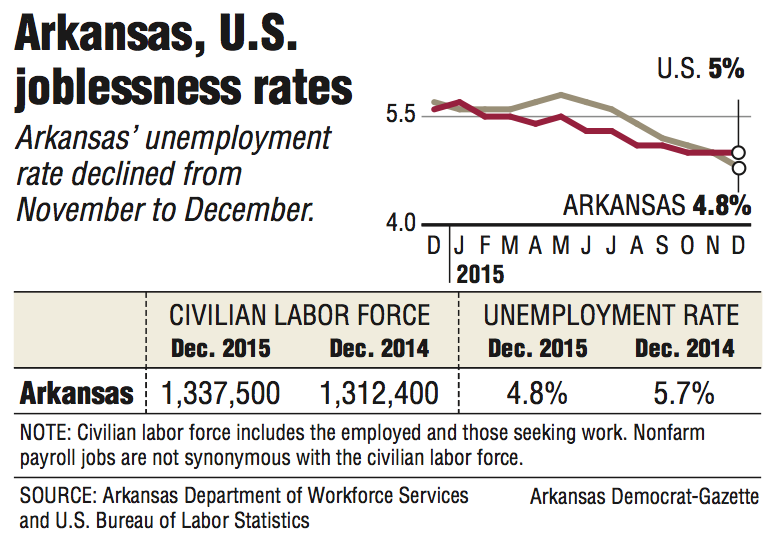Arkansas' unemployment rate dipped to 4.8 percent in December, the lowest since April 2001, the U.S. Bureau of Labor Statistics said Tuesday.
The rate fell two-tenths of a percentage point from 5 percent in November. It has fallen nine-tenths of a percentage point since December 2014 and has steadily declined for seven straight months, said Susan Price with the Arkansas Department of Workforce Services.
The national unemployment rate was 5 percent in December.
In April 2001, the last time the state had an unemployment rate as low as 4.8 percent, the U.S. economy had just tipped into a recession, said Kathy Deck, director of the Center for Business and Economic Research at the University of Arkansas at Fayetteville. Arkansas' unemployment rate had fallen as low as 4.2 percent between April 2000 and September 2000.
Even though the economy was in a recession in early 2001, Arkansas still was at "the high point of the business cycle in the state," Deck said.
The state economy also is doing well now. Economists say the state should continue to have 2 percent to 2.5 percent growth in the near future.
The state's unemployment rate is below 5 percent "for all the right reasons," Deck said.
Arkansas' labor force -- the combination of Arkansans employed and those seeking work -- continues to grow, rising by 25,100 in the past year, or slightly more than 2 percent.
Employment is growing faster than the labor force, climbing more than 3 percent, Deck said.
And the number of unemployed continues to shrink, falling by 9,800 last month.
The number of nonfarm payroll jobs -- estimated from payroll data submitted by thousands of Arkansas employers to the state -- grew by 19,500 from December 2014 to last month.
That is below the trend of about 20,000 nonfarm payroll jobs or more that were added in the later months of 2015, said Michael Pakko, chief economist at the Institute for Economic Advancement at the University of Arkansas at Little Rock.
"That is a little bit of a slowdown but [19,500 jobs] is still a good growth rate," Pakko said.
Eight employment sectors added jobs over the year and three reported declines.
The biggest decline came in manufacturing, which lost 4,500 jobs over 12 months.
Arkansas manufacturing is not performing as well as manufacturing nationally, Deck said.
"And it hasn't been for quite some time," Deck said. "Arkansas manufacturing continues to lag for the past year and a half." The mix of manufacturers in Arkansas is one reason, Deck said.
Arkansas' manufacturers include aerospace and energy-based jobs, such as pipe construction, areas that have had slowdowns, Deck said.
The mining and logging sector lost 800 jobs over a year.
That doesn't include the 600 jobs in the state that Southwestern Energy announced this month that it will cut, Deck said. That will be a 7.4 percent decline in the 8,100 jobs in the mining and logging sector.
But in the perspective of the gain of 19,500 jobs in December, losing 600 jobs is not as significant, Deck said.
Tuesday's unemployment report for December is the final estimate of nonfarm payroll jobs before annual revisions are made by the Workforce Services Department, Pakko said. The revisions, based on more complete employment statistics, will be released March 14, he said.
Pakko said he expects the revision to show 8,000 fewer nonfarm payroll jobs in the state. That includes about 6,000 fewer jobs in the last six months of 2014 and 2,000 fewer jobs last year.
Twenty-five states reported lower unemployment rates in December compared with November, and 14 states reported increases. The rate was unchanged in 11 states.
North Dakota again had the lowest unemployment rate nationally at 2.7 percent, the same as in November. Nebraska and South Dakota were next at 2.9 percent each, followed by New Hampshire at 3.1 percent and Hawaii at 3.2 percent.
New Mexico had the highest rate at 6.7 percent, down from 6.8 percent in November. Alaska was at 6.5 percent, followed by Mississippi and Nevada at 6.4 percent each and West Virginia at 6.3 percent.
A Section on 01/27/2016
